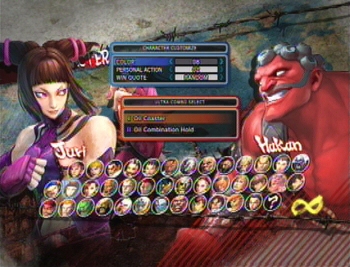
At the character select screen, in addition to picking one of two Ultra Combos, you can also select your desired aesthetics like wardrobe color, personal action (taunt), and win quote. Elsewhere in the options, you can pick English or Japanese voices on a character-by-character basis.
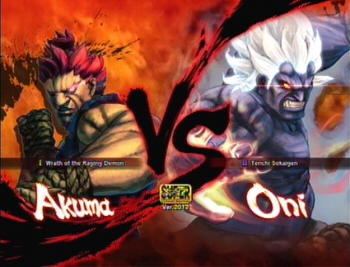
Did we really need both Akuma and (more) evil Akuma? Yes, granted, they play differently, but really? Even the novelty of a buffed up hidden boss-version of a character is old and tired at this point.
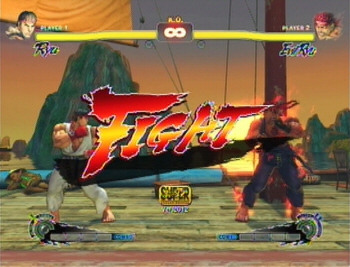
For the love of God, this is 2012! You have 3D models and near limitless storage capacity at your disposal! The days of palette swap sprites died ten freaking years ago! There’s no excuse for this “Evil version of a character” bullshit anymore!
Review by Jay Wilson Once upon a time, I held firmly to the belief that games should be played, and that good gameplay could overcome shortcomings in other areas. I would often cite Castlevania: Symphony of the Night as a prime example with its idiotic dialog and atrocious voice acting. Sometimes I would bring up Street Fighter III: Third Strike which has an uncomfortable mix of normal and screwball characters and a hip hop soundtrack I find painfully grating. But, you know what? Both SotN and SF3:TS are incredibly fun to play. However, one thing that I neglected to acknowledge in my past analysis was both games also came armed with amazing aesthetics that helped eclipsed the flaws. ... and then I played Street Fighter IV. After just looking at the horrendous stylized 3D character models which combine cartoony colors, grotesquely buffed muscle structure, textures that makes their skin look like concrete, plus overly animated bouncy/jumpy/flip-kicky movements to everything they do ... frankly I didn’t give a damn about the gameplay. The characters look “okay” with the camera fully zoomed out where most of the battle takes place, but thanks to the 3D camera Capcom wants to zoom in every chance it gets—performing the new Ultra Combos, during character intros, during the victory poses, during the rival cutscene, before fighting the boss in arcade mode. But that’s not to say the execution is necessarily incompetent. Far from it. It’s just designed to out pizzazz the biggest spectacle on the market which, itself, has more pizzazz than anyone with worthwhile taste can stomach. Capcom calls the new system “2.5D”, as in 3D characters battling on a traditional 2D plane so theoretically it still plays like old school Street Fighter. But there’s a weird artificiality—a kind of uncanny valley effect—to how the characters move. There’s something lifeless, wrong, and lazy about the mechanically perfect rotation of the hurricane kicks and Zangief’s spinning lariats as if the 3D artists just spun the models along the Z axis, making them look like motionless figurines on a turntable. Then strangely enough, despite the 3D offering inherently smoother animation, it often looks inferior to Third Strike. Compare Chun-li’s spinning bird kick in the two games. In Street Fighter III, Chun-li winds up before seamlessly launching herself into the air, flipping upside down, spinning around, and then she comes down—all in one graceful motion. It has such an amazing economy of movement, you can almost imagine an Olympic gymnast performing something similar in their routine. But in IV the animation is so modular, clunky, and step-by-step mechanical; first she flips upside down, next she starts to spin, then she moves forward, then she stops spinning, and lastly she rights herself. On top of that, I can’t escape the feeling that the game is packed with dead time where after performing one move I’m still locked into place and unable to do anything even though it seems like the animation has finished and the character has fully recovered. We’re only talking a fraction of a second, but it sure seems like 80% of the moves linger longer than they should Street Fighter IV introduces Link combos where to connect two attacks together and form a combo, the player must wait for the first attack to completely finish before pressing the next button in the sequence. Some links have to be hit on the exact frame, and considering the game runs at sixty frames per second, that translates to a two hit combo being more difficult than cancelling a normal into a special cancelled again into a super. Having difficult moves isn’t necessarily a bad thing, but it feels insultingly arbitrary making two standing punches against what might as well be a punching bag harder to connect than a complicated multi-part juggle which, by the way, has a reason to be difficult considering you’re hitting a target that is flying through the air and gravity forces the fast and strict timing upon the player—that difficulty is self explanatory. But single-frame links? They feel like Capcom gave its players busy work. 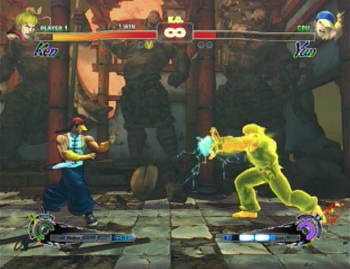
It’s not like the palette swap mainstays of the old sprite days hasn’t left us with enough visual duplication; at least Yun and Ken are different people than Yang and Ryu.
Then strangely enough, Capcom hits the other end of the spectrum making genuinely difficult juggles even more difficult through needless excess. Street Fighter IV also introduces Focus Attacks which, among other things, can be used to cancel moves with long recoveries, and then the Focus Attack can, itself, be cancelled into a forward dash (called a “Focus Attack Dash Cancel” or “FADC”). In plain English, this lets you combo off moves that normally don’t let you combo. And that’s fine, but let’s look at a real combo and, more specifically, look at the mess of inputs required to do it: Ryu has a dragon punch which has no natural follow up. However, he can pop his opponent up with a dragon punch, cancel into an FADC, and juggle with his Ultra Combo (a buffed up Hadouken) for lots of damage. Now, keep in mind, only two moves connect here: an uppercut into a fireball. To do this seemingly simple juggle, after the dragon punch—and while they are in the air falling down—you must now 1.) press medium punch+medium kick [Focus Attack], 2.) immediately tap forward-forward [Dash Cancel]. 3. Perform not one, but two, quarter-circle forward motions and press all three punch buttons [Ultra]. More to the point: it takes eight joystick contact points and five buttons to shoot one—I repeat one—(Ultra) fireball. Oh, and if you’re not fast enough? ... because all this has to be done in the split second when your target is falling? He will hit the ground, the hadouken will miss, the Ultra is wasted, and so is half your Super meter. I like the idea of there being difficult moves and combos. It’s satisfying to master something that once seemed impossible, and even more satisfying when newcomers watch you in action and express their amazement that you can flawlessly execute techniques they can’t even hit in training mode. But ... eight contact points and five buttons to shoot one Ultra fireball off a dragon punch? And why do I have to cancel into a Focus Attack that doesn’t hit because I cancel that before the actual attack comes out? The whole Focus Attack Dash Cancel strikes me as an arbitrary intermediary step. In essence, I’m cancelling a cancel. Why can’t I just cancel the dragon punch straight into the bloody Ultra since those are the only two parts that actually hit? Again, it feels like unnecessary complication for the sake of complication (ie, more busy work.) 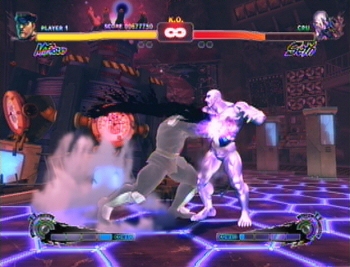
Even SFIV’s crappy boss, Seth, is just a watered down ripoff of SFIII’s Urien who, himself, is a watered down palette swap of that game’s boss.
Now let’s talk about the new Ultra Combos. They work off a second meter called the “Revenge Meter,” located at the end of the Super meter. The Revenge Meter builds up as the player takes damage, and once a character loses about half his life it charges that character’s Ultra. Taking further damage will continue to power up the Ultra allowing it to do more damage. This can lead to bizarre scenarios where Rose can land two hits then Ultra for the win ... or let T. Hawk hit her two times, which will make her Ultra do enough damage to win outright. Thus, to an extent, Ultras negates strategy since now all roads lead to the same place. The idea of these super charged “comeback” moves is to yield more interesting matches because Revenge Meters, being inversely tied to hit points, are guaranteed to charge which can then level the playing field, in theory, keeping the matches closer. But in practice, this leads to frustratingly redundant matches where after decimating Sagat’s life for the first half of the round, I have to enter extreme defense mode because I just gave him a bazooka and the moment I come off guard I’ll lose the lead I worked so hard to get. Let’s say I screw up, and Sagat lands his Ultra. The match is even again, except now my Ultra is ready. Sagat, having spent his, now plays absurdly defensive because he doesn’t want to fall behind again. Thus end games become perpetual turtle fest because a single mistake can be punished so hard by a single move. The beauty of the old school Super Meter is that 1. The player has to fill it by fighting, thus rewarding skillful aggression (even the selective aggression of an overall defensive player) and 2. The player has choices on how to use it (EX moves, Focus Attack Cancels, Supers), so two Dhalsims might play completely differently, creating variety, thus creating interesting matches. Options = interesting. There’s only one way to fill the Revenge meter (losing life), and there’s only one use for it (Ultras). Monotony = boring. But it’s even worse than that because the Revenge Meter is guaranteed to fill, and since there’s nothing else you can do with it the Ultras are then guaranteed to happen frequently. So, monotony + relentless repetition = extreme boredom. 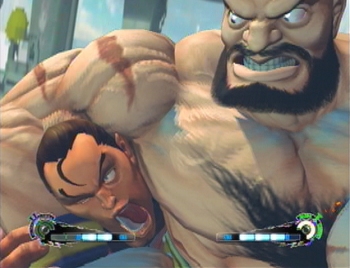
Fact: Ultras are designed to wow reviewers and spectators who will quickly abandon the game; meanwhile, dedicated fighting game fans get a shallow self-defeating game mechanic and will be doomed to watch the same fucking unskippable cutscene over and over and over again.
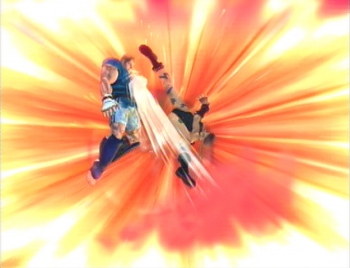
I mean, seriously, aren’t Super Combo finishes with the big flashy starburst spectacle enough? And what ever happened to having a choice of Supers? We get to choose between two Ultras, why not a choice of Supers?
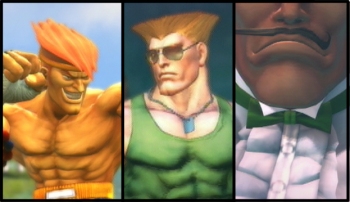
In general, the Alpha and Third Strike characters don’t look so bad in this stylized 3D, but the Street Fighter II characters look like grotesque caricatures that inexplicably fall victim to the uncanny valley effect.
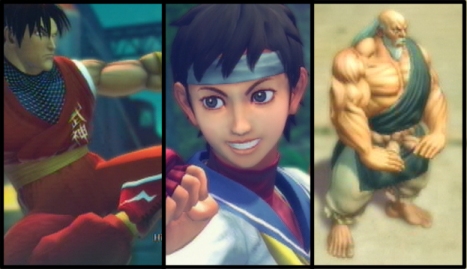
For the first time ever Ken and Ryu’s master, Gouken (right), appears in a Street Fighter game, and I have never been so underwhelmed and unimpressed. Has everyone forgotten the artistically sound lesson of Jaws and Alien that often it’s better to leave things to our imagination?
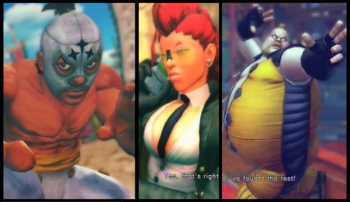
Look at Crimson Viper (center) and notice how her tie doesn’t fall into her cleavage like it should which makes it look like she has a unaboob ... which is as stupid looking as it is disgusting.
And yet it still gets worse: a high damage Ultra serves the same purpose as a high damage Super Combo, and with so much tied to the Super meter ... why bother saving up for a Super combo? Especially when you know your Ultra will become available before you lose? It defeats the whole strategic element of spending a finite resource. But the final nail in the coffin is that Ultras are mini-cutscenes that yields the same animations from the same series of camera angles, zooming in to draw attention to its repetition (not to mention giving an extreme close up to the grotesque character models), and in some cases taking almost ten full seconds to complete which doesn’t sound like that long but consider this: a single Ultra can take up over 10% of a single round and a close match might see two Ultras (20%). Twenty percent of a battle becomes dead time, watching a movie where the player can do nothing. No pressing the advantage. No strategic positioning. No interaction. Nothing. As for the roster, Arcade Edition assembles something of a “greatest hits” of the various Street Fighter games. However, even though I’ve played all the games and mained close to a dozen characters across the years, the only familiar face I enjoyed picking up again was Cammy whom I used in Super Street Fighter II Turbo (ST). For everyone else, though, I couldn’t help but think “isn’t it time these guys retired?” Especially since after Street Fighter III boldly went with a mostly new cast, bringing back all twelve original SF2 characters just feels shallow and timid. Even the inclusion of Alpha’s Adon, Gen, Sakura, Rose, Guy, and Cody plus Third Strike’s Yun, Yang, Dudley, Ibuki, and Makoto feels like a retread. I guess that’s what Capcom gets for releasing Street Fighter II five times, Alpha 2 twice, Street Fighter III three times, and throwing everything but the kitchen sink into Alpha 3 (and we’re not even going into the Versus series.) But a new game means new characters, and that’s where IV fails the most. These newcomers run the full spectrum of abysmal design decisions to the point they feel like the mold covered scum growing at the bottom of Capcom’s inspiration barrel. There’s a female secret agent, Crimson Viper, who wears an outfit that combines the professionalism of a business suit with the cleavage exposing casualness of a spaghetti strap. Supposedly, her wardrobe is a weapon allowing her to channel electricity, kick fire, and cause mild earthquakes. Next is Abel whose appearance is a perfect mirror to his amnesia-induced lack of a personality. Non-descript face, non-descript hair, non-descript blue gi with bicycle shorts—he looks like an uninspired late night rough sketch that didn’t go anywhere or one of those colorless fashion mannequins some kids put random clothes on. His fighting style is equally uninspired and bland, rolling on the ground to dodge certain attacks, picking up his opponent, and twirling them around like a watered down Zangief throw. And those are the serious characters. For comic relief, in an already giddy gay game, we get El Fuerte, a hyperactive masked Mexican wrestler who aspires to open his own restaurant; he annoyingly dashes all over the places (complete with squeaky shoe sounds) and performs jumping splashes and acrobatic throws named after food. Then there’s Rufus, a morbidly obese loudmouth biker moron, who resembles a Mr. Potatohead made out of jello. He fights like Bruce Lee crossed with Kevin Smith crossed with the Tazmanian devil (complete with a cartoony tornado Ultra.) And as much as I want to, I can’t leave out Hakan, the red skinned and green haired Turkish oil Wrestler who greases himself up, squeezes his opponent until they slip from his grasp and shoot across the screen. In Street Fighter IV’s defense, however, these are not the absolute worst character designs in the Street Fighter universe. That dishonor still goes to R. Mika from Alpha 3. As much as I dislike the game, I must confess Super Street Fighter IV did introduce one of the greatest characters the franchise has seen in a long long time: Juri, the evil Korean henchwoman. Psychotic, sadistic, and backstabbing she fills the desperately needed role of a non-goofy character—a serious character—a dark, yet still fun, villainess in a game sorely lacking in the villain department (the lame collection of rip offs known as Seth doesn’t count, and both Bison [dictator] and Akuma devolved into caricatures seventeen years ago.) Her design nicely balances exotic and mundane elements, making her both memorable and believable—hair done up like horns and glowing artificial eye, wearing a skimpy top and baggy pants which feels comfortably at home in the video game universe. More importantly, I enjoyed her play style with a dive kick and teleport to get around fireballs, a pinwheel kick for combos and evasion, and the ability to store her own multi-directional fireballs for later instantaneous release. But the thing I adore most about Juri? One of her Ultras just makes her glow white for a limited time, letting her link attacks together she normally couldn’t. Or, in other words, Juri’s Ultra lets me continue playing the game. It’s a cruel twist of fate that my favorite Street Fighter character appears in the game I hate the most. | ||||||||||||||||||||
|
| ||||||||||||||||||||
